Opportunities That Lie Beyond The Low-Default Era

One of the hallmarks of the current market environment is the numerous macro issues that could affect credit fundamentals going forward. Rather than focusing on issues with highly uncertain outcomes, we’re more confident in the broad effects from the collective reduction in central bank liquidity. Namely, it will mark the end of the low-default era and the revival of a multi-year cycle that many will find unfamiliar as default rates revert to higher, historical norms.
As we assess the coming default cycle, we can draw some generalizations about the effects of cheap capital—and its subsequent withdrawal—in the leveraged finance markets. The influx of capital distorted market structure in areas such as ownership, investment objectives, and financial symmetry. These distortions will increasingly come to the fore as liquidity evaporates and restricts the flow of capital to where it is needed most. As a result, more borrowers and equity sponsors facing credit situations will likely seek “self help” by exploiting weak covenants to extend optionality and attract opportunistic capital, regardless of the market conditions.
For investors who are unprepared for the increase in special situations activity, it presents risks that can cut two ways. Their credit positions could be subordinated and consequently devalued over the course of several transactions as the cycle matures. This collective experience can lead to secondary effects, such as foregoing allocations that potentially generate equity-like returns in otherwise sound businesses. Navigating these risks requires familiarity with the approaching conditions, recognition of the potential capital needed throughout the cycle, and awareness of the opportunity set created through market dispersion.
Uncomfortably Numb
Given the prolonged environment of central bank liquidity, it’s not surprising that many investors have become accustomed to longer business cycles, lower default rates, and cheaper capital. For example, Figure 1 shows that two of the prior four business cycles set records for their longevity and each was about three times longer than the average extending back to 1854. Further to the influence of monetary accommodation, the COVID-related default cycle—which was countered by an unprecedented global central bank response—was the fastest of the prior four cycles to drop below its pre-recession lows.
From the perspective of historical default rates, Figure 2 highlights the market’s altered state amid the liquidity deluge as default rates since 2004 were nearly 50% below their long-term average and 70% below the pre-GFC average.
Figures 1 & 2: The extension in U.S. business cycles contributed to the low-default era (default rate %)
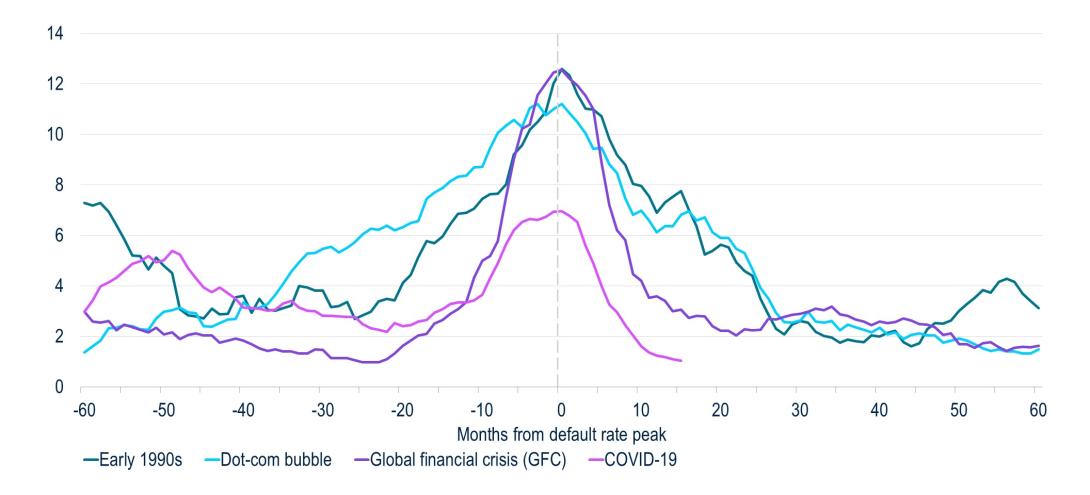
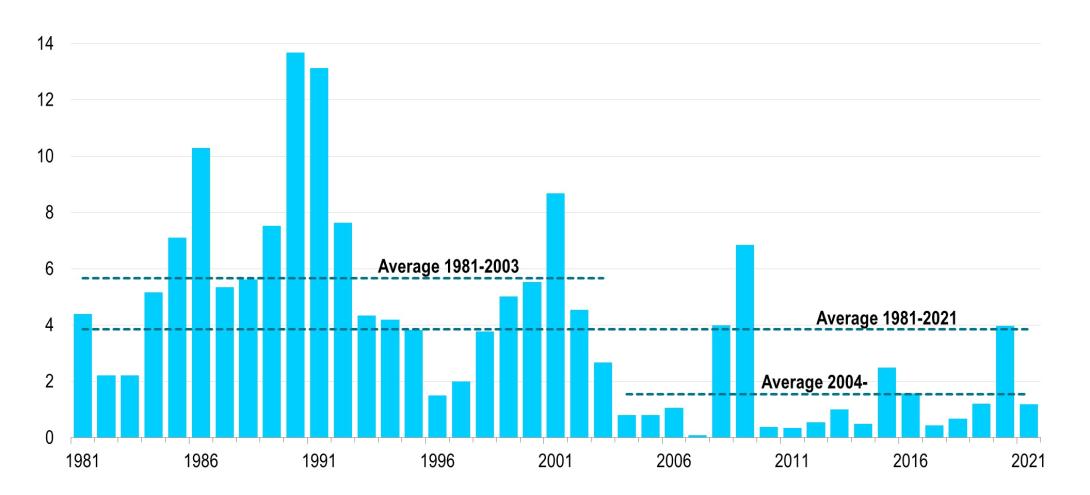
Source: PGIM Fixed Income, NBER, Bloomberg and Moody’s Investors Service.
Changes in central bank reserves may also contribute to a higher cost of capital for borrowers with lasting effects. Figure 3 shows how U.S. investment grade credit spreads have shifted in tandem with global central bank reserves in recent years. With reserves set to decrease, the potential for wider spreads—not to mention the effects from the global surge in policy rates—increases the cost of a corporation’s debt refinancing or new debt capital.
As policy tightening lowers the net present value on strategic and growth capital, it will also expose other, idiosyncratic problems not readily visible to the marketplace. These include operating inefficiencies, bloated costs, negative operating leverage, and unbalanced cash flow generation.
Figure 3: Credit spreads have moved in tandem with central bank reserves (LHS: in $ trillions; RHS: in bps, inverted)
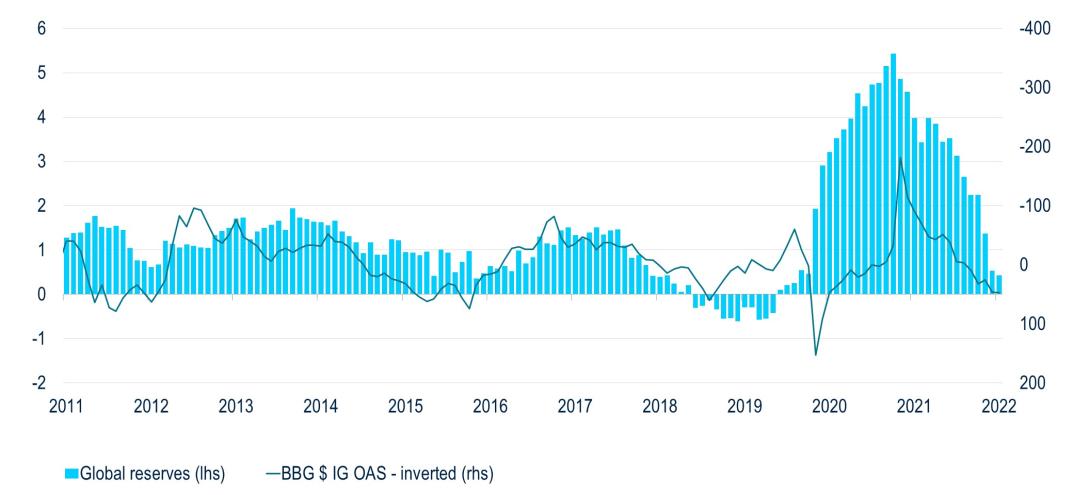
Source: Citi Research. As of May 31, 2022.
As borrowers confront increased capital costs as well as the prospects of business cycles and default rates that revert to historical trends, it isn’t surprising that many will take a proactive approach to achieving a more stable credit profile rather than relying on market conditions. Therefore, those capitalizing on the embedded optionality within loose covenants will force the issue and drive the increase in distressed and special situations activity within the leveraged finance markets.1 While many of these situations will undoubtedly draw investor interest given the potential returns, the question shifts to whether there is enough capital available to capitalize on the opportunities.
How Much Dry Powder is Sufficient?
Considering the prolonged benefits of central bank liquidity, investors may believe that about $100 billion in dry powder may be sufficient to manage through the coming distressed situations in the U.S. and maintain the status quo in terms of credit conditions. However, $100 billion may only be a fraction of what is needed, and a few remnants from the prior cycle shape our estimates for the amount of dry powder needed going forward.
The first is the growth in the leveraged finance markets, which roughly doubled in size following the GFC in an expansion that is often overlooked by investors who focused on private direct lending or private equity. Figure 4 shows that when either the current level of market distress or Moody’s 1-year forward default rate is applied to the outstanding debt in the U.S. and European leveraged finance markets, a distress level emerges that is 2-5 times the amount of allocated dry powder.
A more moderate scenario, which looks at the median level of max distress in every recession going back into the mid-1980s, would create more than $1.4 trillion of opportunity. Moody’s moderate and extreme scenarios only consist of one-year default projections (13% and 19%, respectively).
Given our view of the economic backdrop we believe the next cycle will resemble those which occurred with relative frequency before the GFC when the average five-year cumulative default rate was around 30%, i.e., 6% per year. Considering that the length of this default cycle will likely be measured in years, not months or quarters, roughly $100 billion in dry powder could be less than half of what is needed to navigate just one year of the cycle.
Figure 4: The progression of U.S. distressed scenarios vs. dedicated capital (in $ billions)

Source: PGIM Fixed Income, Moody’s Investors Service, and Preqin
Powder May be Dry, but Stranded
How did we get here? With the market-related effects of central bank liquidity (e.g., historically low interest rates) in mind, it’s easy to understand allocators’ decision to move into private equity and private direct lending, particularly given the illiquidity premiums and other advantages of holding illiquid, hard-to-value assets. Figure 5 highlights the surge in direct lending capital from essentially zero in 2006 to a peak of nearly 50% of private debt capital raised in 2021. That increase came at the expense of distressed and special situations capital, which declined from about 50% per annum to around 20-25% over the last several years.
Now that these private buckets are full (thanks in part to the denominator effect), the pressing question becomes how capital will shift into more opportunistic debt strategies, which have a far lower stockpile of dedicated capital (Figure 6). The simple answer is that it probably won’t.
Figures 5 & 6: Distressed and special situations consistently trail direct lending in debt capital raises (Figure 5: %; Figure 6: in $ billions)
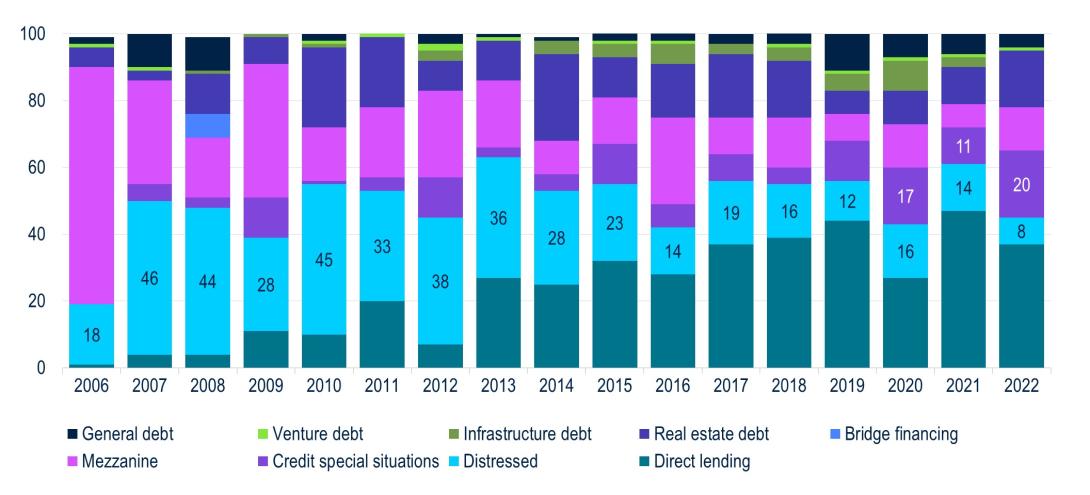
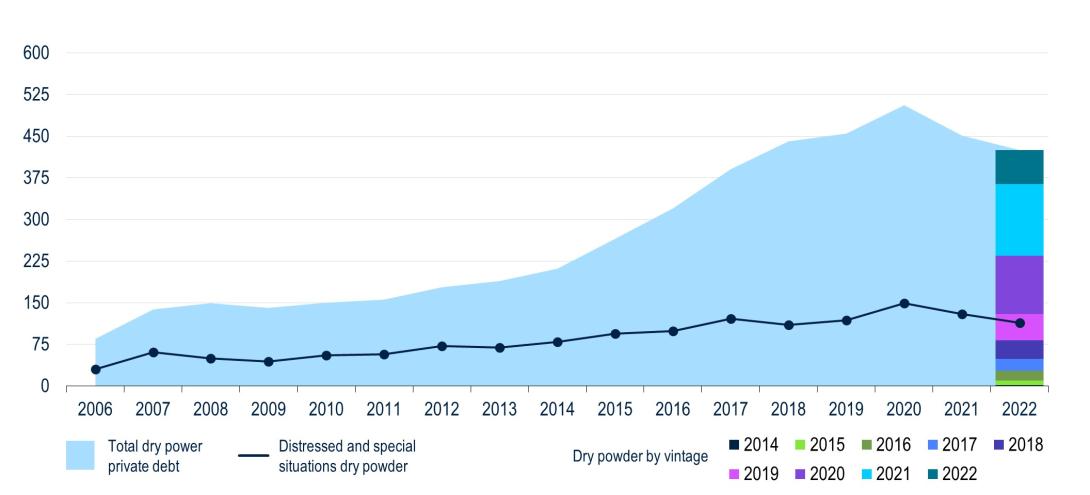
Source: PGIM Fixed Income and Pitchbook H1 2022 Global Private Debt Report. YTD as of June 30, 2022.
We struggle to see existing direct lending managers and their dry powder pivot into distressed and special situations in the public fixed income market given mandate limitations and the general lack of qualifications. Additionally, we expect a portion of the dry powder will be used to reduce portfolio leverage in private investment vehicles as the credit cycle matures and asset marks push leverage to untenable levels.
Although there is about $1.3 trillion in private equity dry powder, we suspect a portion of that capital will be reserved to defend existing transactions through subsequent equity injections and leverage reductions. We highlight these trends as a rebuttal to the preconceived notion that there is a considerable amount of dry powder “waiting to capitalize when markets dislocate.”
Structural Dispersion and its Opportunities
The points above culminate with observations from the changing levels of structural dispersion in leveraged credit spreads. Figure 7 shows that spread dispersion was steadily increasing before the pandemic and took a multi-year hiatus amid central banks’ unprecedented responses. This incentivized investors’ reach-for-yield—often amongst those unfamiliar with the leveraged finance sector—leading to the distortions mentioned at the top of the post. Those often serve as catalysts for distressed and special situations transactions as the distortions essentially tighten financial conditions in specific credits further than what is experienced at the index level.
Although dispersion has recently increased, it remains less than pre-pandemic levels, thus increasing the risk that valuations quickly gap lower to the surprise of unsuspecting investors.
Figure 7: The structural dispersion in leveraged credit spreads reflects various distortions and can catalyze special situations transactions (U.S. single B OAS in bps)
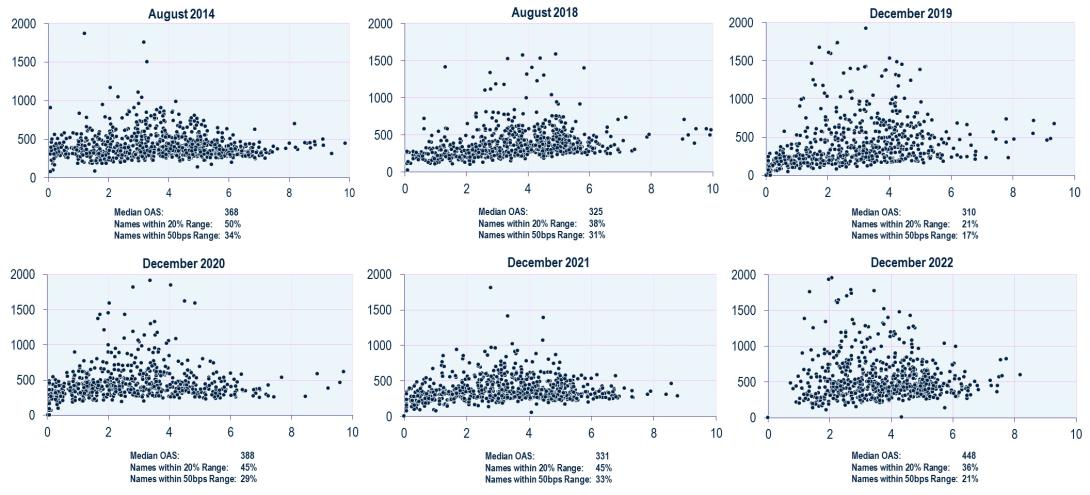
Source: Bloomberg. As of September 30, 2022.
Conclusion
Unlike the last two default cycles (i.e., those pertaining to the GFC and the pandemic) where the generic market dislocations warranted broad exposure, this cycle will arrive amidst a vast withdrawal of central bank liquidity. The idiosyncratic distortions exposed by the pullback in liquidity point to a prolonged period of “self help” by companies and sponsors, which may create a level of volatility and opportunity that surprises many participants. As we assess the complex cycle upon us, we’re keenly interested in second and third derivative distressed opportunities that we expect to emerge this year and next.
While developments during the coming cycle could be jarring for investors who ignore the uptick in special situations activity, they can also reveal attractive risk/reward opportunities for those with adequate dry powder and the experience to navigate an array of situations. Indeed, enhanced discipline, patience, and in-depth analysis of unique situations will be required to meet the primary challenge of unlocking a company’s needs and capitalizing on the opportunities that lie beyond the low-default era.
1 We define distressed as >750 bps of OAS.
Read More from PGIM Fixed Income
Source(s) of data (unless otherwise noted): PGIM Fixed Income, as 1/19/2023.
For Professional Investors only. Past performance is not a guarantee or a reliable indicator of future results and an investment could lose value. All investments involve risk, including the possible loss of capital.
PGIM Fixed Income operates primarily through PGIM, Inc., a registered investment adviser under the U.S. Investment Advisers Act of 1940, as amended, and a Prudential Financial, Inc. (“PFI”) company. Registration as a registered investment adviser does not imply a certain level or skill or training. PGIM Fixed Income is headquartered in Newark, New Jersey and also includes the following businesses globally: (i) the public fixed income unit within PGIM Limited, located in London; (ii) PGIM Netherlands B.V., located in Amsterdam; (iii) PGIM Japan Co., Ltd. (“PGIM Japan”), located in Tokyo; (iv) the public fixed income unit within PGIM (Hong Kong) Ltd. located in Hong Kong; and (v) the public fixed income unit within PGIM (Singapore) Pte. Ltd., located in Singapore (“PGIM Singapore”). PFI of the United States is not affiliated in any manner with Prudential plc, incorporated in the United Kingdom or with Prudential Assurance Company, a subsidiary of M&G plc, incorporated in the United Kingdom. Prudential, PGIM, their respective logos, and the Rock symbol are service marks of PFI and its related entities, registered in many jurisdictions worldwide.
These materials are for informational or educational purposes only. The information is not intended as investment advice and is not a recommendation about managing or investing assets. In providing these materials, PGIM is not acting as your fiduciary. PGIM Fixed Income as a general matter provides services to qualified institutions, financial intermediaries and institutional investors. Investors seeking information regarding their particular investment needs should contact their own financial professional.
These materials represent the views and opinions of the author(s) regarding the economic conditions, asset classes, securities, issuers or financial instruments referenced herein. Distribution of this information to any person other than the person to whom it was originally delivered and to such person’s advisers is unauthorized, and any reproduction of these materials, in whole or in part, or the divulgence of any of the contents hereof, without prior consent of PGIM Fixed Income is prohibited. Certain information contained herein has been obtained from sources that PGIM Fixed Income believes to be reliable as of the date presented; however, PGIM Fixed Income cannot guarantee the accuracy of such information, assure its completeness, or warrant such information will not be changed. The information contained herein is current as of the date of issuance (or such earlier date as referenced herein) and is subject to change without notice. PGIM Fixed Income has no obligation to update any or all of such information; nor do we make any express or implied warranties or representations as to the completeness or accuracy.
Any forecasts, estimates and certain information contained herein are based upon proprietary research and should not be interpreted as investment advice, as an offer or solicitation, nor as the purchase or sale of any financial instrument. Forecasts and estimates have certain inherent limitations, and unlike an actual performance record, do not reflect actual trading, liquidity constraints, fee. These materials are not intended as an offer or solicitation with respect to the purchase or sale of any security or other financial instrument or any investment management services and should not be used as the basis for any investment decision. PGIM Fixed Income and its affiliates may make investment decisions that are inconsistent with the recommendations or views expressed herein, including for proprietary accounts of PGIM Fixed Income or its affiliates.
Investing in the bond market is subject to risks, including market, interest rate, issuer, credit, inflation risk, and liquidity risk. The value of most bonds and bond strategies are impacted by changes in interest rates. Bonds and bond strategies with longer durations tend to be more sensitive and volatile than those with shorter durations; bond prices generally fall as interest rates rise, and low interest rate environments increase this risk. Reductions in bond counterparty capacity may contribute to decreased market liquidity and increased price volatility. Bond investments may be worth more or less than the original cost when redeemed. Mortgage- and asset-backed securities may be sensitive to changes in interest rates, subject to early repayment risk, and while generally supported by a government, government agency or private guarantor, there is no assurance that the guarantor will meet its obligations. High yield, lower-rated securities involve greater risk than higher-rated securities; portfolios that invest in them may be subject to greater levels of credit and liquidity risk than portfolios that do not. Investing in foreign-denominated and/or -domiciled securities may involve heightened risk due to currency fluctuations, and economic and political risks, which may be enhanced in emerging markets. Currency rates may fluctuate significantly over short periods of time and may reduce the returns of a portfolio. Commodities contain heightened risk, including market, political, regulatory and natural conditions, and may not be suitable for all investors. Diversification does not ensure against loss.
In the United Kingdom, information is issued by PGIM Limited with registered office: Grand Buildings, 1-3 Strand, Trafalgar Square, London, WC2N 5HR. PGIM Limited is authorised and regulated by the Financial Conduct Authority (“FCA”) of the United Kingdom (Firm Reference Number 193418). In the European Economic Area (“EEA”), information is issued by PGIM Netherlands B.V., an entity authorised by the Autoriteit Financiële Markten (“AFM”) in the Netherlands and operating on the basis of a European passport. In certain EEA countries, information is, where permitted, presented by PGIM Limited in reliance of provisions, exemptions or licenses available to PGIM Limited under temporary permission arrangements following the exit of the United Kingdom from the European Union. These materials are issued by PGIM Limited and/or PGIM Netherlands B.V. to persons who are professional clients as defined under the rules of the FCA and/or to persons who are professional clients as defined in the relevant local implementation of Directive 2014/65/EU (MiFID II). In certain countries in Asia-Pacific, information is presented by PGIM (Singapore) Pte. Ltd., a Singapore investment manager registered with and licensed by the Monetary Authority of Singapore. In Japan, information is presented by PGIM Japan Co. Ltd., registered investment adviser with the Japanese Financial Services Agency. In South Korea, information is presented by PGIM, Inc., which is licensed to provide discretionary investment management services directly to South Korean investors. In Hong Kong, information is provided by PGIM (Hong Kong) Limited, a regulated entity with the Securities & Futures Commission in Hong Kong to professional investors as defined in Section 1 of Part 1 of Schedule 1 (paragraph (a) to (i) of the Securities and Futures Ordinance (Cap.571). In Australia, this information is presented by PGIM (Australia) Pty Ltd (“PGIM Australia”) for the general information of its “wholesale” customers (as defined in the Corporations Act 2001). PGIM Australia is a representative of PGIM Limited, which is exempt from the requirement to hold an Australian Financial Services License under the Australian Corporations Act 2001 in respect of financial services. PGIM Limited is exempt by virtue of its regulation by the FCA (Reg: 193418) under the laws of the United Kingdom and the application of ASIC Class Order 03/1099. The laws of the United Kingdom differ from Australian laws. In Canada, pursuant to the international adviser registration exemption in National Instrument 31-103, PGIM, Inc. is informing you that: (1) PGIM, Inc. is not registered in Canada and is advising you in reliance upon an exemption from the adviser registration requirement under National Instrument 31-103; (2) PGIM, Inc.’s jurisdiction of residence is New Jersey, U.S.A.; (3) there may be difficulty enforcing legal rights against PGIM, Inc. because it is resident outside of Canada and all or substantially all of its assets may be situated outside of Canada; and (4) the name and address of the agent for service of process of PGIM, Inc. in the applicable Provinces of Canada are as follows: in Québec: Borden Ladner Gervais LLP, 1000 de La Gauchetière Street West, Suite 900 Montréal, QC H3B 5H4; in British Columbia: Borden Ladner Gervais LLP, 1200 Waterfront Centre, 200 Burrard Street, Vancouver, BC V7X 1T2; in Ontario: Borden Ladner Gervais LLP, 22 Adelaide Street West, Suite 3400, Toronto, ON M5H 4E3; in Nova Scotia: Cox & Palmer, Q.C., 1100 Purdy’s Wharf Tower One, 1959 Upper Water Street, P.O. Box 2380 - Stn Central RPO, Halifax, NS B3J 3E5; in Alberta: Borden Ladner Gervais LLP, 530 Third Avenue S.W., Calgary, AB T2P R3.
© 2023 PFI and its related entities.
2023-8807
Sign Up Now for Full Access to Articles and Podcasts!
Unlock full access to our vast content library by registering as an institutional investor .
Create an accountAlready have an account ? Sign in
